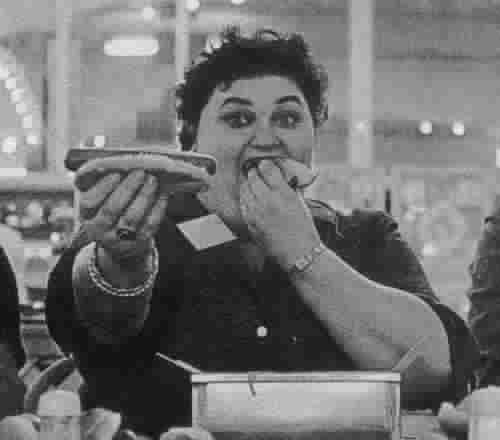
Ritual. The usually friendly patterns of eye contact, gestures, and words exchanged at midday while consuming food products.
LUNCH

Ritual. The usually
friendly patterns of eye
contact, gestures, and words exchanged at midday while consuming
food products.
Usage: We "do lunch," schedule luncheon meetings, and conduct business over lunch because eating together a. reduces anxiety as the parasympathetic nervous system switches to rest-and-digest, and b. promotes sociability through the reptilian principle of "acting alike" and "doing the same thing" (see ISOPRAXISM).
Courtship. Because lunch is conducted in the light of day, it is an effective venue for the early exchange of love signals. As in the more serious dinnertime rite (usually conducted after dark; see below, Media), couples find eating together less stressful than conversing without the shared focus of utensiles, food, and drink.
Media. "The next day, Vicki offers to cook Gary dinner at his
apartment. Thinking quickly, Gary says his place is too messy; they decide to
have lunch at the ranch instead." --Young and Restless (Soap Opera
Digest synopsis, May 2, 2000:114)
Corporate culture. Office
rituals invariably involve eating and drinking together. Nonverbally, food
consumption allies staff and draws employer and employees closer together. (But
note that food is rarely served during performance reviews.) To win friends
and influence people in the firm, chocolates work better than words.
Ancient history. Food is a powerful symbol, as the Egyptian artists who drew ritual offerings of food and drink on tomb walls understood 2,500 years ago.
Prehistory. Unlike other primates, human beings have been sharing edibles for at least two million years, as evidenced by arrangements of cut and broken big-game bones found in sites at Olduvai Gorge, Tanzania. The earliest-known ritual involving food is found in Upper Paleolithic cave paintings dating to between 34,000 and 12,000 years ago. The cave walls show big-game animals speared or caught in what may have been "magical" traps (Wenke 1990).
Neuro-notes. Mirror neurons: In primates including human beings, there appear to be highly developed nervous-system pathways, and accompanying mirror neurons, involved in bringing food to the mouth with the hands. (See, e.g., Maurizio Gentilucci's abstract for the 2012 conference on "Mirror Neurons: New Frontiers 20 Years After Their Discovery.") This may explain a behavior I have seen for years, viz., that people closely monitor the eating and drinking actions of others, at county fairs and in other public places, in diners, village squares, waiting rooms, and cafes. Thanks to mirror neurons, watching a woman eat a hotdog brings more than a little vicarious pleasure. It is as if we, ourselves, were eating the hotdog.See also CONFERENCE TABLE, DANCE.
Copyright 1999 - 2016 (David B.
Givens/Center for Nonverbal
Studies)
Photo of friendly meat-eater (picture credit: unknown)